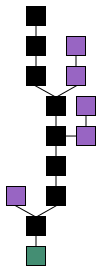Blockchain
Security Attacks, Challenges, and Solutions for the Future
Distributed IoT Network - Review
|

Blockchain elements.

Blockchain components.
Blockchain technology is becoming increasingly attractive to the
next generation, as it is uniquely suited to the information
era. Blockchain technology can also be applied to the Internet
of Things (IoT). The advancement of IoT technology in various
domains has led to substantial progress in distributed systems.
Blockchain concept requires a decentralized data management
system for storing and sharing the data and transactions in the
network. Here the blockchain concept and
relevant factors that provide a detailed analysis of potential
security attacks are discussed and existing solutions that can be
deployed as countermeasures to such attacks are presented. Blockchain security enhancement solutions
are also included by
summarizing key points that can be exploited to develop various blockchain
systems and security tools that counter security
vulnerabilities. Open issues
relating to and future research directions of blockchain-IoT
systems are pointed out.
---
The
blockchain paradigm is changing the IT industry. Blockchain can
bring together companies, governments, and even countries.
Blockchain technology is widely recognized and highly valued due
to its decentralized nature and peer-to-peer characteristics.
The main takeaway of this review is that the authors have
thoroughly analyzed several attacks on blockchain and the
security issues of blockchain with some real-world examples.
Moreover, this review discussed the various security issues,
challenges, vulnerabilities, and attacks that impede the
increased adoption of blockchain technology while exploring
these challenges in a variety of aspects. Other blockchain applications and benefits
are explained, and
many related opportunities at the business level are discussed.
Existing security solutions for different
environments and open issues are also presented. Read more at
the IEEE review paper:
Blockchain Security Attacks, Challenges, and Solutions for the
Future Distributed IoT Network (pdf)

Blockchain
A blockchain is a decentralized, distributed and public digital
ledger that is used to record transactions across many computers
so that the record cannot be altered retroactively without the
alteration of all subsequent blocks and the collusion of the
network.
A blockchain is a continuously growing list of records, called
blocks, which are linked and secured using cryptography. Each
block typically contains a cryptographic hash of the previous
block, a timestamp and transaction data. By design, a blockchain
is inherently resistant to modification of the data. It is "an
open, distributed ledger that can record transactions between
two parties efficiently and in a verifiable and permanent way".
For use as a distributed ledger, a blockchain is typically
managed by a peer-to-peer network collectively adhering to a
protocol for inter-node communication and validating new blocks.
Once recorded, the data in any given block cannot be altered
retroactively without the alteration of all subsequent blocks,
which requires collusion of the network majority.
Blockchains are secure by design and exemplify a distributed
computing system with high Byzantine fault tolerance.
Decentralized consensus has therefore been achieved with a
blockchain. This makes blockchains potentially suitable for the
recording of events, medical records, and other records
management activities, such as identity management, transaction
processing, documenting provenance, food traceability or voting.
Blockchain was invented by Satoshi Nakamoto in 2008 for use in
the cryptocurrency bitcoin, as its public transaction ledger.
The invention of the blockchain for bitcoin made it the first
digital currency to solve the double spending problem without
the need of a trusted authority or central server. The bitcoin
design has been the inspiration for other applications.
|
TACS
is Pioneer and Innovator of many Communication Signal
Processors, Optical Modems, Radio Modems, 5G Modems, 6G Modems,
Satellite Modems, PSTN Modems, Cable Modems, PLC Modems, and
more..
TACS
consultants are the first inventors of fixed or mobile packet
radio structures in the world.
|
TACS is a leading top consultancy in the field of information, communication
and energy technologies (ICET).
The heart of our consulting spectrum comprises strategic,
organizational, and technology-intensive tasks that arise from the use of new
information, communication and energy technologies.
The major emphasis in our work is found in innovative consulting and
implementation solutions which result from the use of modern information,
communication and energy technologies.
TACS
- Delivers the insight and vision
on technology for strategic decisions
- Drives
innovations forward as part of our service offerings to customers
worldwide
- Conceives
integral solutions on the basis of our integrated business and technological
competence in the ICET sector
- Assesses technologies and standards and develops
architectures for fixed or mobile, wired or wireless communications systems
and networks
- Provides
the energy and experience of world-wide leading innovators and experts in their fields for local,
national or large-scale international projects.
|